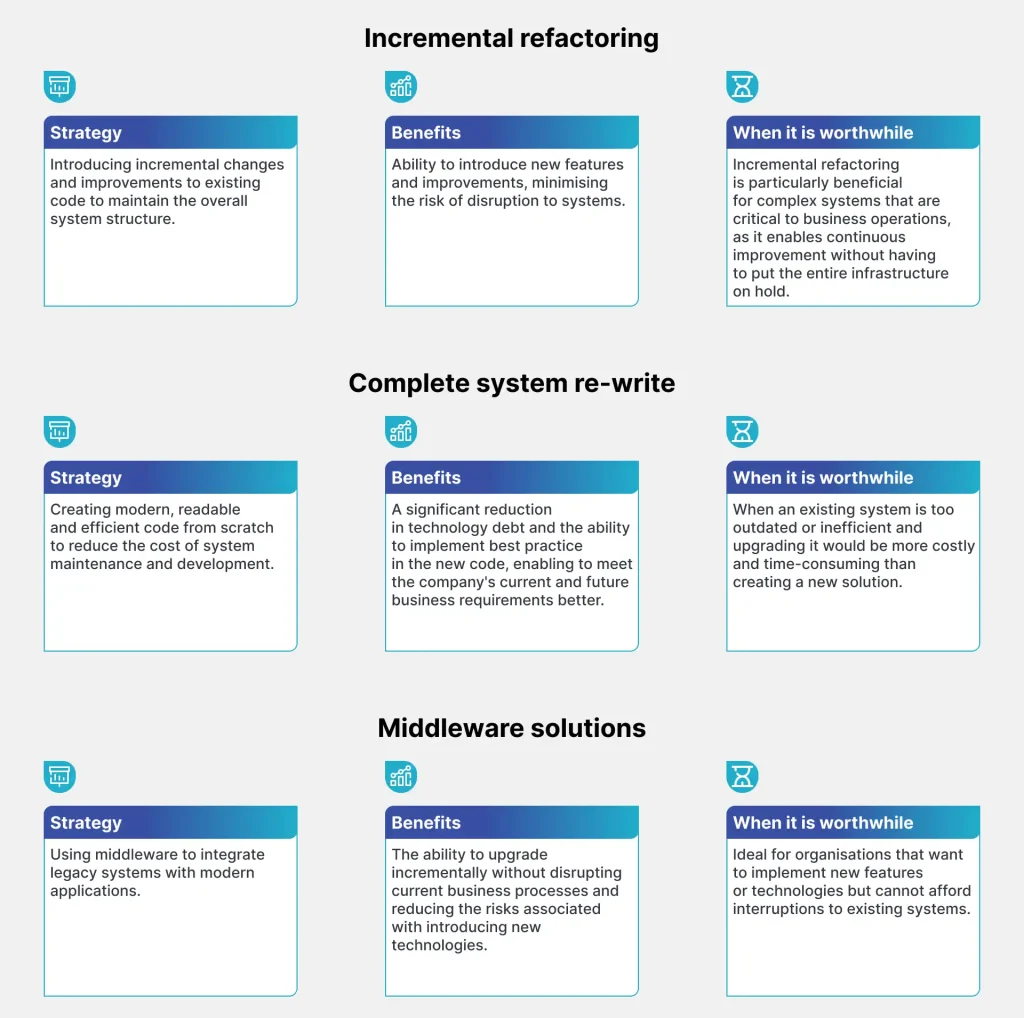Legacy Code is a hidden barrier to a company's growth process – it increases technology debt, stifles innovation and reduces company efficiency. Despite the many challenges of maintaining such a code, the right approach can open the door to new opportunities. Learn how to minimise the risk of unnecessary costs and exploit the opportunities hidden in Legacy Code.
Key takeaways from this article
- Maintaining the Legacy Code generates technology debt that inhibits innovation and business flexibility, which can be minimised through a strategic approach to modernisation.
- Legacy Code offers unique development and learning opportunities for IT teams, especially in terms of creative problem solving and understanding of legacy technologies.
- A strategic approach, such as incremental refactoring, manages the risks associated with Legacy Code while increasing the company’s flexibility without compromising critical business operations.
Legacy Code – how does technology debt affect your costs and efficiency?
A code that has been neglected and overwritten becomes increasingly expensive and difficult to preserve over the years. It generates additional maintenance and repair costs thus preventing the company from increasing its profits. An old code makes it significantly more difficult to integrate systems with modern technologies, which slows down or stops the company's growth altogether, and effectively closes the way to innovative solutions. Each project involving the implementation of new tools becomes a costly and time-consuming endeavour, affecting the overall efficiency of the company's operations.

Missed development opportunities – how does the Legacy Code hold back innovation?
The biggest drawback of the Legacy Code is its considerable impact on a company's flexibility, understood as its ability to innovate and adapt to changes in the market. When a company's IT resources are consumed by maintaining old systems and dealing with avoidable errors, the ability to develop new products is greatly diminished. Medium and large companies which expect to gain a strong foothold in the market must fully exploit the potential of innovative solutions: otherwise they lose customers to agile and flexible competitors.

Deepening shortage of specialists
One important, but often overlooked, issue in confronting Legacy Code is its impact on the company's workflow. Finding and retaining developers who are proficient in legacy coding languages becomes an expensive challenge for the enterprise. Many professionals prefer to develop in newer, more exciting technologies and are reluctant to deal with outdated solutions. Meanwhile, programmers with the seniority and knowledge of older solutions are slowly disappearing from the market, consistently extending the shortage of talent that can effectively maintain older code. This situation exposes the organisation to numerous technical problems and long-term inefficiencies.
SAP, a global leader in enterprise software, has lately faced the difficult task of maintaining systems built on the ABAP (Advanced Business Application Programming) language. Although ABAP was innovative and remarkable in its time, today it is extremely difficult to find programmers with the right knowledge and experience to use it. In addition, the retiring employees are exacerbating the knowledge gap, jeopardising the effective management of critical systems.
Legacy Code management strategies – how to avoid further losses?
Managing Legacy Code successfully requires a thoughtful strategy that combines the company's current business needs with long-term modernisation plans. Here are three of the best approaches to modernising Legacy Code that will solve the problem of outdated code and open the way to innovation.

Legacy Code – hidden benefits for development
Outdated code, despite the many challenges and problems it causes, can become a valuable tool in expanding the skills of your IT team. It allows you to understand the evolution of technology and design decisions, and can serve as an excellent training space for new developers. Working with legacy systems enables your team to acquire creative problem-solving skills. This approach to Legacy Code not only supports the maintenance of legacy systems, but also grants building a team capable of bridging the gaps between old and new technologies.
Conclusion
Companies focused on growing and strengthening their position in the market should take a strategic approach to modernising the Legacy Code to minimise the risk of major concerns and avoid incurring hidden costs as soon as possible. The key to withdrawing from Legacy Code-induced technology debt is first and foremost about balance – preserving the value of existing systems while leveraging new technologies. Companies that proactively plan for modernisation pave the way for innovation and long-term success.



